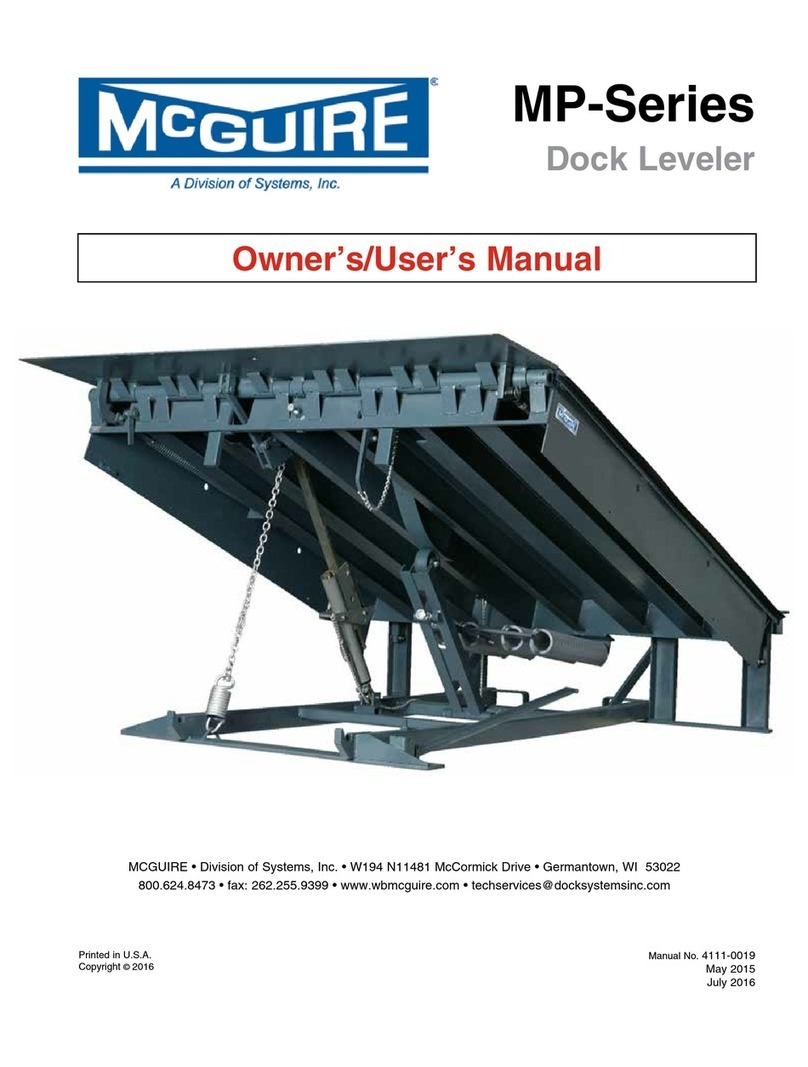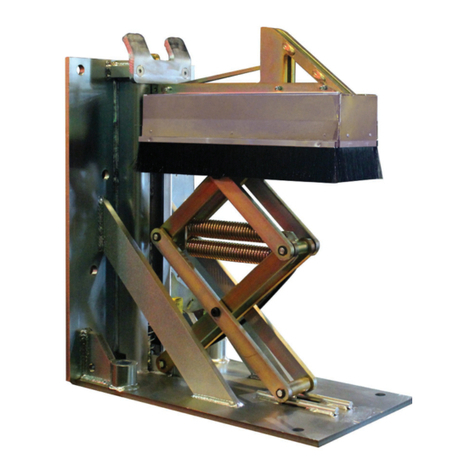
64111-0026 — Feb. 2019
©2019 Systems, LLC
1) The manufacturer shall provide to the initial
purchaser and make the following information
readily available to the owners/users and their
agents, all necessary information regarding
Safety Information, Operation, Installation and
Safety Precautions, Recommended Initial and
Periodic Inspections Procedures, Planned
Maintenance Schedule, Product Specifications,
Troubleshooting Guide, Parts Break Down,
Warranty Information, and Manufacturers
Contact Information, as well as tables to identify
the grade(slope) for all variations of length or
configuration of the dock leveling device and
information identifying the maximum uncontrolled
drop encountered when sudden removal of
support while in the working range of the
equipment.
2) When selecting loading dock safety equipment,
it is important to consider not only present
requirements but also future plans and any
possible adverse conditions, environmental
factors or usage. The owners/users shall provide
application information to the manufacturer
to receive recommendations on appropriate
equipment specifications and capacity.
3) The owner/user must see all nameplates,
placards, decals, instructions and posted
warnings are in place and legible and shall not
be obscured from the view of the operator or
maintenance personnel for whom such warnings
are intended for. Contact manufacturer for any
replacements.
4) Dock leveling devices may become hazardous
if the manufacturer’s instructions regarding
modifications or adjustments are not followed.
Modifications or alterations of dock leveling
devices shall only be made with prior written
approval from the original manufacturer. These
changes shall be in conformance with all
applicable provisions of the MH30.1 standard
and shall also satisfy all safety recommendations
of the original equipment manufacturer of the
particular application.
5) The owner/user should recognize the inherent
dangers of the interface between the loading
dock and the transport vehicle. The owner/ user
should, therefore, train and instruct all operators
in the safe operation and use of the loading dock
equipment in accordance with manufacturer’s
recommendations and industry standards.
Effective operator training should also focus on
the owner’s/user’s company policies, operating
conditions and the manufacturer’s specific
instructions provided with the dock leveling
device. Maintaining, updating and retraining all
operators on safe working habits and operation of
the equipment, regardless of previous experience,
should be done on a regular basis and should
include an understanding and familiarity with all
functions of the equipment. Owners/users shall
actively maintain, update and retrain all operators
on safe working habits and operations of the
equipment.
6) An operator training program should consist of,
but not necessarily be limited to, the following:
a) Select the operator carefully. Consider the
physical qualifications, job attitude and aptitude.
b) Assure that the operator reads and fully
understands the complete manufacturer’s owners/
users manual.
c) Emphasize the impact of proper operation
upon the operator, other personnel, material
being handled, and equipment. Cite all rules and
why they are formulated.
d) Describe the basic fundamentals of the dock
leveling device and components design as related
to safety, e.g., mechanical limitation, stability,
functionality, etc.
e) Introduce the equipment. Show the control
locations and demonstrate its functions.
Explain how they work when used properly and
maintained as well as problems when they are
used improperly.
f) Assure that the operator understands the
capacity rating, nameplate data, placards and all
precautionary information appearing on the dock
leveling device.
g) Supervise operator practice of equipment.
h) Develop and administer written and practical
performance tests. Evaluate progress during and
at completion of the course.
i) Administer periodic refresher courses. These
may be condensed versions of the primary course
and include on-the-job operator evaluation.
OWNER’S/USER’S RESPONSIBILITIES





























